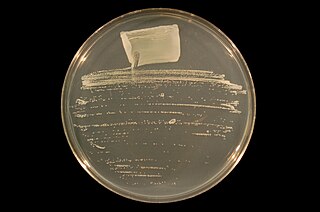The Aquificae phylum is a diverse collection of bacteria that live in harsh environmental settings. The name 'Aquificae' was given to this phylum based on an early genus identified within this group, Aquifex, which is able to produce water by oxidizing hydrogen. They have been found in springs, pools, and oceans. They are autotrophs, and are the primary carbon fixers in their environments. These bacteria are Gram-negative, non-spore-forming rods. They are true bacteria as opposed to the other inhabitants of extreme environments, the Archaea.

The Rhizobiaceae is a family of proteobacteria comprising multiple subgroups that enhance and hinder plant development. Some bacteria found in the family are used for plant nutrition and collectively make up the rhizobia. Other bacteria such as Agrobacterium tumefaciens and A. rhizogenes severely alter the development of plants in their ability to induce crown galls or hairy roots found on the stem. The family has been of an interest to scientists for centuries in their ability to associate with plants and modify plant development. The Rhizobiaceae are, like all Proteobacteria, Gram-negative. They are aerobic, and the cells are usually rod-shaped. Many species of the Rhizobiaceae are diazotrophs which are able to fix nitrogen and are symbiotic with plant roots.
In taxonomy, Ruegeria is a genus of the Rhodobacteraceae. This genus was formerly known as the marine Agrobacterium before they were reclassified in 1998. It bears in fact the name of Hans-Jürgen Rüger, a German microbiologist, for his contribution to the taxonomy of marine species of Agrobacterium.

Sinorhizobium/Ensifer is a genus of nitrogen-fixing bacteria (rhizobia), three of which have been sequenced.
In taxonomy, Leisingera is a genus of the Rhodobacteraceae.
In taxonomy, Marinovum is a genus of the Rhodobacteraceae. Up to now there is only one species of this genus known.
In taxonomy, Methylarcula is a genus of the Rhodobacteraceae.
In taxonomy, Phaeobacter is a genus of the Rhodobacteraceae.
In taxonomy, Sulfitobacter is a genus of the Rhodobacteraceae.
In taxonomy, Thalassobacter is a genus of the Rhodobacteraceae. (Proteobacteria)
In taxonomy, Halalkalicoccus is a genus of the Halobacteriaceae.
In taxonomy, Halobiforma is a genus of the Halobacteriaceae. Species include:
Halopiger is a genus of archaeans in the family Halobacteriaceae that have high tolerance to salinity.
In taxonomy, Halosimplex is a genus of the Halobacteriaceae.
In taxonomy, Halovivax is a genus of the Halobacteriaceae. Some species of Halovivax are halophiles and have been found in Iran's Aran-Bidgol hypersaline lake.
In taxonomy, Natrinema is a genus of the Halobacteriaceae.
In taxonomy, Natronorubrum is a genus of the Halobacteriaceae.

Arcanobacterium is a genus of bacteria. They are gram-positive, non–acid fast, nonmotile, facultatively anaerobic, and non–endospore forming. They are widely distributed in nature in the microbiota of animals and are mostly innocuous. Some can cause disease in humans and other animals. As with various species of a microbiota, they usually are not pathogenic but can occasionally opportunistically capitalize on atypical access to tissues or weakened host defenses.
The Negativicutes are a class of bacteria in the phylum Firmicutes, whose members have a peculiar cell wall with a lipopolysaccharide outer membrane which stains gram-negative, unlike most other members of the Firmicutes. Although several neighbouring Clostridia species also stain gram-negative, the proteins responsible for the unusual diderm structure of the Negativicutes may have actually been laterally acquired from Proteobacteria. Additional research is required to confirm the origin of the diderm cell envelope in the Negativicutes.
Pararhizobium is a genus of Gram-negative soil bacteria that fix nitrogen. It has been segregated from the genus Rhizobium. Pararhizobium forms an endosymbiotic nitrogen-fixing association with roots of legumes.



